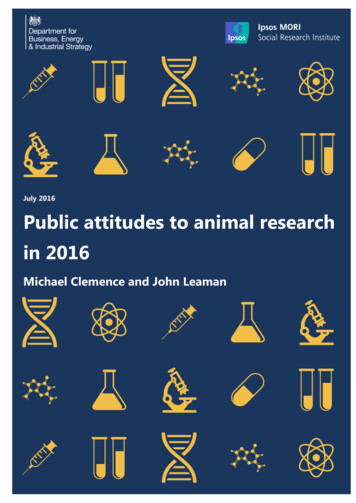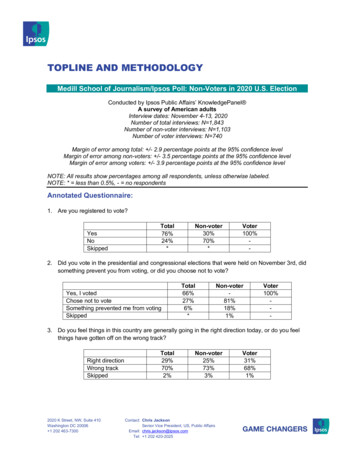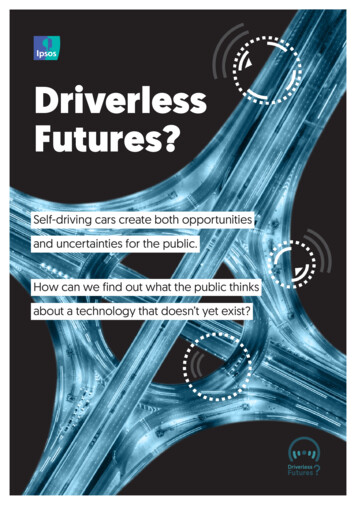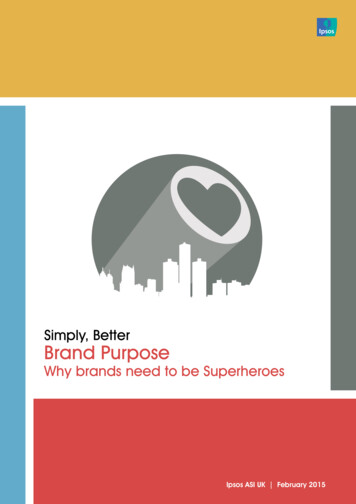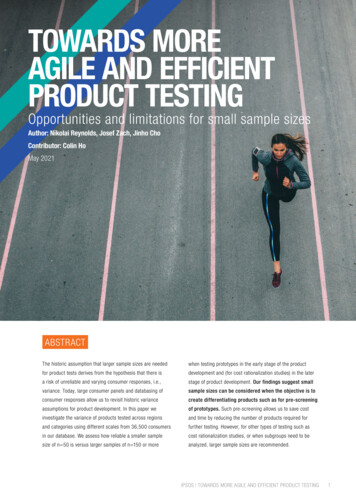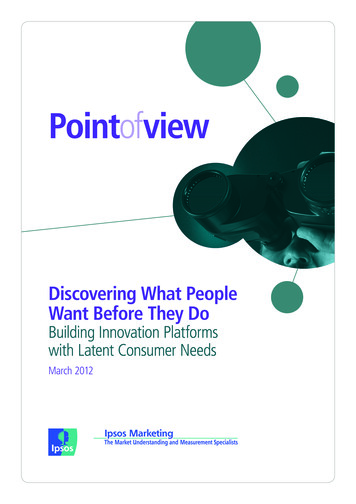
Transcription
PointofviewDiscovering What PeopleWant Before They DoBuilding Innovation Platformswith Latent Consumer NeedsMarch 2012
D I S C O V E R I N G W H AT P E O P L E WA N T B E F O R E T H E Y D ODove knew it. Danone knew it. Mr. Clean and 3M knew it too.These brands knew they needed to go beyond finding new ways to meetconsumers’ existing needs. In order to achieve long-term growth they neededto uncover something different: new needs to address.So, instead of focusing exclusively on developing new flavors and scents andfinding ways to improve product effectiveness, these companies looked forunconscious consumer needs that had not yet emerged: latent needs.Sunando DasGlobal Head of Marketing Science,Ipsos MarketingMarket Understanding andMeasurement (MUM)sunando.das@ipsos.comWhile marketers continually tap into current drivers of brand choice to maximizetheir market share, they also need to think about their innovation platformsfor tomorrow. One way to do this is to uncover latent needs that consumerscannot easily articulate. The discovery of latent needs is one way marketerscan identify insights, which is a critical step during the fuzzy front end ofinnovation. Marketers who can awaken latent needs among consumers havea strong competitive advantage. They can develop innovation platforms basedon benefits that are not yet delivered by any other player in the market.Case in point: the shower gel category in an Asian country in the early 2000s.During that time, the importance of moisturization in driving brand preferencein the shower gel category was only 3%. When Dove introduced a shower gelthat offered moisturization as its core benefit, importance of moisturizationamong consumers jumped to over 12% within two years. Moisturization wasa latent consumer need on which Dove was able to capitalize.Trying to discover a need that consumers don’t even know they have soundsintimidating. Exactly how do marketers identify these hidden needs and howcan they be sure they have hit upon the right ones? The solution comes fromobserving consumer behavior and knowing the right questions to ask.The Power of Latent NeedsMr. Clean Magic EraserMarketers face quite a challenge in trying tomanage efforts across present and futureopportunities, and often the exploration into latentneeds becomes a less important priority comparedto optimizing present drivers of brand choice.However, given the impact that capitalizing onlatent needs can have on a brand, it should be anintegral part of the growth strategy. Some examplesof the power of latent needs:Mr. Clean Magic Eraser realized that consumerswould gladly relinquish their old habit of cleaninghousehold surfaces with a sponge and spray cleanerin favor of a self-contained sponge that cleanedsurfaces using water alone. Mr Clean addressed thelatent need for effective removal of dirt with theconvenience of just a swipe – no additional cleaningsolutions necessary.Danone Activia Yogurt3M Post-It NotesDanone realized that rich, creamy traditionalyogurts were not as appealing in the U.S., whichtrailed far behind France in terms of yogurtconsumption. To help grow the brand in the U.S.,Danone identified a latent need in the form ofdigestive health and launched Activia, which wasalready commercialized in Europe. Activia was a hitin the U.S., generating 130 million in sales in thefirst year.3M hit upon a latent need when it developed Post-ItNotes. The product was not a great success at firstas consumers had never seen anything like it and didnot appreciate its usefulness. However, freesampling and demonstration activities convincedconsumers of the product’s relevance and it becamea worldwide success. Post-It Notes addressed thelatent need for a convenient way to hang a notewherever you want without using tape.2Copyright 2012 Ipsos. All rights reserved.
D I S C O V E R I N G W H AT P E O P L E WA N T B E F O R E T H E Y D OConsumer Delight Holds the Keyto Awakening Latent NeedsSo, how can marketers uncover latent needs and how do they know if they willresonate with consumers? The key is to uncover which new needs or unsolvedneeds could delight consumers.Sources of consumer delight can be derived through a qual-quant approachthat leads to the discovery and validation of latent needs.Step One: Qualitative ExplorationThe first step is a qualitative approach to uncover the potential latent needs ina category.The goals are to understand:1. What are the potential unsolved needs in a category; and2. What new needs could emerge in the category, based on macroeconomic,socio-demographic and consumer trends?The qualitative research should result in an initial list of potential latent needs,which will be further explored and verified through quantitative research. Theupfront qualitative work is a pre-requisite to quantitative work, as it incorporatesthe voice of the consumer into the quantitative survey and leads to greaterspecificity of the attributes that will be tested.The qualitative research will vary from study to study and may entail ethnography,consumer ideation, or internal ideation based on prior problem resolutionstudies. The qualitative research should decipher which consumer needs areunsolved with respect to category usage and consumption and identify potentialnew (and possibly unconscious needs) which would delight consumers.For example, L’Oreal recently introduced L’Oreal Men Expert Excell 5 hair dye,which takes only five minutes to apply and fulfils the need for fast hair colorapplication. Further qualitative research could potentially reveal that consumersare dissatisfied with the hair coloring process being a separate groomingprocess – whether they realize it or nor. Hence, they may have a latent needfor ease of application which could be met by incorporating the dye into ashampoo product3Copyright 2012 Ipsos. All rights reserved.
D I S C O V E R I N G W H AT P E O P L E WA N T B E F O R E T H E Y D OStep Two: Quantitative ConfirmationBy definition, latent needs are drivers which do notdrive present brand choice in the market. Instead,latent needs represent new drivers in the categorywhich consumers would like to see. The initial list ofthese potential new drivers would be provided atthe qualitative stage through the understanding ofpotential sources of dissatisfaction in the categoryor inferring of potential new needs which coulddelight consumers.In the map below, the x-axis represents theimportance of an attribute in driving present brandchoice. The x-axis represents the consumer’sconscious desire for an attribute. For example,consumers may proactively seek low-calorie cookiesto lose weight.The y-axis represents the potential level of futureconsumer delight that would be achieved if the needwere fulfilled. For example, again thinking about thecookie category, consumers might be delighted bythe idea of a cookie that delivered on the need tosuppress hunger, even if consumers could notconsciously express their need for hunger suppression.To distinguish consumers’ latent needs from theircurrent needs, we can organize needs on twodimensions: how important they are in drivingpresent brand choice and the level of futureconsumer delight they would generate if the marketdelivered on them.Figure 1.Level of Future Consumer DelightFramework for Different Types of Consumer NeedsLatent Consumer Need(e.g., Hunger Suppression Cookies)Unfulfilled Consumer Needs(e.g., Low-Calorie Cookies)Consumer Needs to be IgnoredFulfilled Consumer NeedsImportance in driving Present Brand ChoiceBased on these two dimensions, we can define consumer needs as follows: BLUE QUADRANT: LATENT CONSUMER NEED This need is not important to consumers today whenchoosing a brand as no brand currently delivers on this need, but consumers would be delighted if aproduct delivered on this need in the future. This area represents a latent need as it taps into a desirewhich would delight consumers tomorrow and, as such, may offer good potential for long-term growth. ORANGE QUADRANT: UNFULFILLED CONSUMER NEED This need is important to consumers todaybut is not delivered well by the present market; hence, consumers would be delighted if the productdelivered more of this. This area represents an unfulfilled consumer need and a good potential sourcefor growing present market share. GREEN QUADRANT: FULFILLED CONSUMER NEED While this need is highly important to consumerstoday, their need is fulfilled by the present market; therefore, consumers would not be delighted if aproduct delivered more of this. This area represents a fulfilled consumer need. WHITE QUADRANT: CONSUMER NEED TO BE IGNORED This need does not drive present brand choiceand consumers are indifferent to the level of delivery by the present market. This area represents needsthat are basically fulfilled and do not offer much in terms of present or future growth potential.4Copyright 2012 Ipsos. All rights reserved.
D I S C O V E R I N G W H AT P E O P L E WA N T B E F O R E T H E Y D OThe challenge in identifying latent needs is finding ways to elicit fromconsumers the needs which are not addressed by any player in the presentmarket but would delight them if delivered tomorrow (i.e., changes consumerswould like to see in the future). This is what the qualitative stage uncoversfollowed by validation in the quantitative stage.Ipsos Marketing R&D found that when consumers were asked directly aboutwhat changes they would like to see in a category in the future, there was verylittle differentiation in the data between the different potential latent needsuncovered in the qualitative stage. This makes it difficult to shortlist the truelatent needs.In order to reveal true consumer latent needs, we recommend a derivative ofthe Kano methodology. Kano methodology is a model that offers insight intothe product attributes which are perceived to be important to consumers. Ourapproach uses one simple question, which is an adaption of the Kanomethodology, for each of the needs in the category (existing needs as well aspotential new latent needs). These needs were elicited in the qualitative stagebut need to be shortlisted in the quantitative phase.Our Kano-adapted question about existing and potential latent needs, alone,is not adequate to identify the latent needs. We need to understand thepresent drivers of brand choice as well. We can ascertain present drivers ofbrand choice through an Ipsos Brand Perceptor study. At its core, BrandPerceptor identifies present drivers of brand choice through a dynamic,predictive model based on functional and emotional needs. Brand Perceptorprovides the x-axis in the Framework for Different Consumer Needs (Figure 1)and the Kano methodology question provides the y-axis in the framework.Future latent needs are drivers which consumers indicate are low in importancein a Brand Perceptor study, but say they would be delighted or happy if a branddelivered on these needs.As is clear from the approach outlined above, the quality of the latent needsemerging from the study are dependent on the quality and specificity ofattributes used, as gleaned from the qualitative phase.We need to keep in mind that the latent needs we identify are also a functionof stage of category evolution in a country – what might emerge as a latentneed in a country with relatively lower category evolution may already beaddressed by brands in a country with relatively higher category evolution – aswas the case with Activia yogurt mentioned earlier.Latent Needs Help Drive InnovationThe identification of latent needs can help drive the fuzzy front end ofinnovation. Once latent needs are discovered and validated, marketers canleverage them to develop innovation platforms and, in turn, generate ideasand develop concepts.Deciding on innovation platforms is a critical step during the fuzzy front end,as decisions about which platforms to pursue will have repercussions for manyyears. Financial investments are high; opportunity costs can be even higher.Latent needs provide a lens for the consumer needs of tomorrow, and as suchcan help marketers shape their innovation platforms by helping them to decide: Which business opportunities should I investigate? Which strategic targets should I focus on? Do I need to re-position my brand and, if so, how?By identifying latent needs through a qual-quant approach today, marketersare setting a course for growth for tomorrow.5Copyright 2012 Ipsos. All rights reserved.
About Ipsos MarketingIpsos Marketing helps clients identify businessopportunities on their markets, innovate andposition their brands, and maximise sales to getthe best return on investments. It includes fourglobal practices: Innovation and Forecasting,Market Understanding and Measurement,Healthcare and Qualitative.Ipsos Marketing experts transform consumerinsights into our clients’ competitive advantage. Weoffer innovative contractual models to bettermanage Market Research expenditures. Wedistribute information real-time within clients’organizations by leveraging technology andactivation sessions. We integrate knowledge bycombining various sources of data.Copyright 2012 Ipsos. All rights reserved.Ipsos Marketing is a specialization of Ipsos, a globalmarket research company which delivers insightfulexpertise across six specializations: advertising,customer loyalty, marketing, media, public affairsresearch, and survey management. With offices in84 countries, Ipsos has the resources to conductresearch wherever in the world our clients dobusiness. In October 2011 Ipsos completed theacquisition of Synovate. The combination forms theworld’s third largest market research company.In 2011, Ipsos generated global revenues of 1.363billion (1.897 billion USD), Marketing researchcontributing to nearly 50% of Ipsos revenues.Visit www.ipsosmarketing.com to learn more1 2 - 0 2 - 2 6
Mr. Clean Magic Eraser Mr. Clean Magic Eraser realized that consumers would gladly relinquish their old habit of cleaning household surfaces with a sponge and spray cleaner in favor of a self-contained sponge that cleaned surfaces using water alone. Mr Clean addressed the latent need for effective removal of dirt with the
